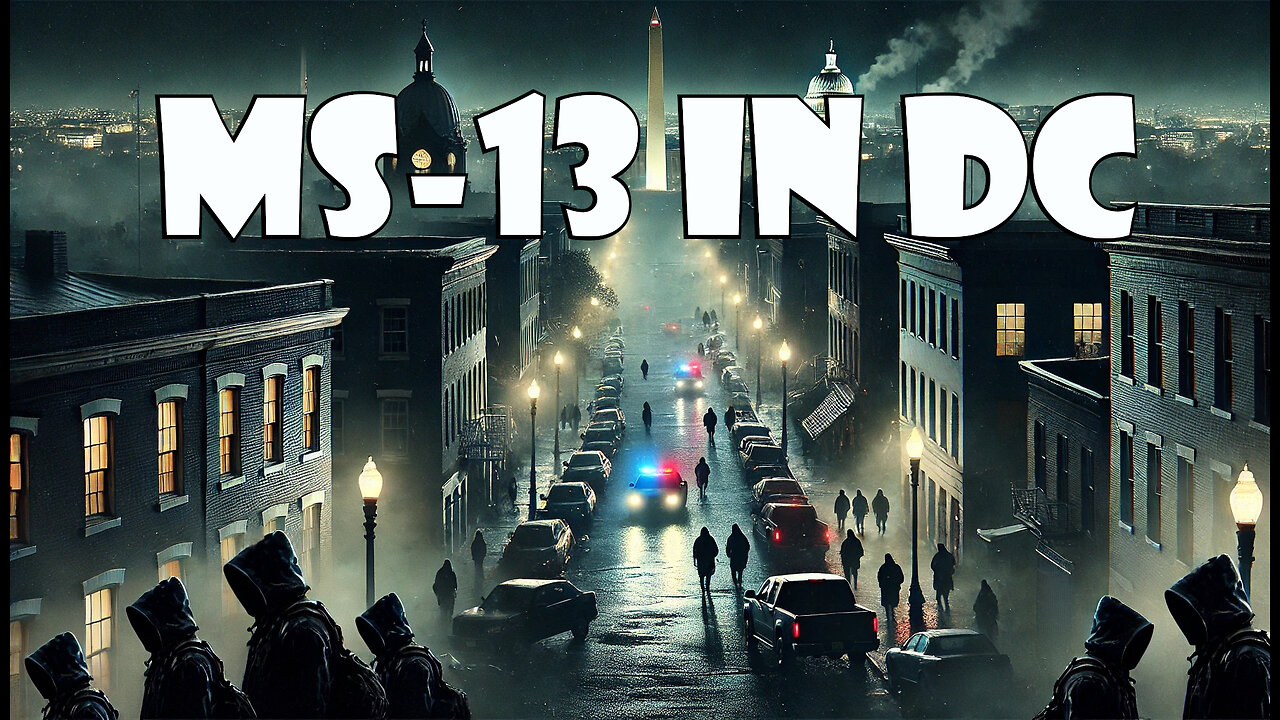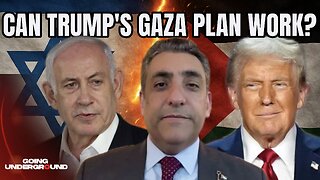Premium Only Content

Tracking MS-13 | Active Threat To Washington D.C.?
I. Executive Summary
The recent apprehension of Henrry Josue Villatoro Santos, a top-level MS-13 commander, in Woodbridge, Virginia—approximately 15 miles from the U.S. Capitol—represents a significant disruption in MS-13's operational capabilities on the U.S. East Coast. However, deeper analysis reveals substantial cause for concern. The arrest highlights the intersection of three critical conditions: an unprecedented strategic opportunity (created by recent FBI resource redistribution), a robust motive (heightened by the Trump administration's aggressive actions against MS-13 and other Central American gangs), and the presence of a substantive threat (Santos himself armed and strategically positioned). This triad strongly suggests that Santos's presence near Washington, D.C., was not merely coincidental or passive, but rather indicative of an imminent threat scenario—one whose full scope remains unclear due to the current lack of secondary apprehensions or network disruptions.
II. Contextual Background
A. FBI Resource Redistribution
In early 2025, the FBI executed a significant redistribution of resources away from its headquarters in Washington, D.C., decentralizing approximately 1,500 agents and employees. Around 1,000 personnel were reassigned across various field offices nationwide, while another 500 moved to facilities in Huntsville, Alabama. Ostensibly aimed at increasing operational effectiveness nationwide, this redistribution created a short-term vulnerability—a strategic soft zone—in the greater Washington metropolitan area.
From an operational security perspective, this shift diminished the density and responsiveness of federal law enforcement and intelligence oversight in the immediate region surrounding the nation's capital. It is plausible—and highly likely—that sophisticated criminal organizations such as MS-13 would recognize and attempt to exploit this temporary gap in enforcement capability.
B. Trump Administration’s Aggressive Gang Countermeasures
Concurrently, the Trump administration significantly escalated actions against MS-13 and other prominent Central American gangs. Recent measures included:
Designation of MS-13 and other gangs as Foreign Terrorist Organizations (FTOs), enabling more aggressive enforcement, surveillance, and international cooperation.
Utilization of the Alien Enemies Act of 1798, resulting in mass deportations of suspected gang affiliates—over 200 to El Salvador alone—heightening internal pressure within gang leadership.
Deployment of sophisticated surveillance capabilities, including satellite and AI-driven monitoring, designed to severely restrict gang mobility and communication channels.
These actions created existential pressures on MS-13’s senior leadership, precipitating potential retaliatory or demonstrative actions to reassert operational credibility and organizational cohesion.
III. Subject Profile and Operational Intent
Henrry Santos is known within MS-13 as a strategic-level leader responsible for logistical and operational coordination across the gang’s East Coast network. His history demonstrates consistent expertise in managing transnational communication channels, logistical networks, weapon procurement, and strategic planning. Santos's presence in Woodbridge, Virginia, armed and reportedly without immediate visible backup, indicates a specific and carefully calculated operational decision—particularly given his status as one of the FBI’s highest-priority MS-13 fugitives.
Given this profile, Santos was highly unlikely to undertake direct operational risk without substantial strategic benefit. The following motives and intents are consistent with his known capabilities and patterns:
Direct Command and Control: Possibly to finalize or authorize critical operational steps related to a planned violent event, retaliation, or network restructuring.
Symbolic Operational Demonstration: To signal MS-13’s ability to operate near federal centers of power, potentially as a deterrent against further U.S. policy aggression.
Contingency or Crisis Leadership: To reorganize regional operational cells under immediate and escalating pressure from U.S. authorities.
IV. Imminent Threat Indicators
Several critical threat indicators strongly suggest Santos’s presence represents an imminent operational scenario rather than routine evasion or criminal activity:
Strategic Placement and Timing: Arrival in a suburban zone with quick access to high-value targets (political or symbolic) precisely at the moment of federal resource displacement.
Armed Presence: Immediate access to firearms indicates readiness or operational contingency, not passive or defensive concealment.
Lack of Accomplices Captured: The absence of secondary arrests following his apprehension strongly indicates either a compartmentalized network structure or undiscovered supporting operational cells.
Political and Operational Context: Immediate and heightened U.S. federal policy pressure creating an environment in which retaliatory or demonstrative violence would have maximal impact, particularly given proximity to Washington, D.C.
This combination of indicators aligns precisely with profiles of individuals preparing imminent violent acts, direct leadership actions, or contingency responses.
V. Potential Operational Objectives and Risks
Given the context and indicators, the following scenarios are assessed as highly plausible:
Scenario A: Coordinated Multi-Node Attack or Symbolic Violence: Santos’s presence as direct oversight could indicate preparations for simultaneous violent acts across the D.C. region, intended to overwhelm local enforcement and underscore gang strength amidst federal challenges.
Scenario B: Assassination or Targeted Attack: Given the proximity to government, military, intelligence, and political institutions, MS-13’s leadership might have intended a targeted act against political figures, local authorities, or symbolic targets in direct retaliation against federal measures.
Scenario C: Demonstrative Retaliation: Planned operations against law enforcement personnel, local officials, or rival factions as symbolic retaliation against recent administration actions, using the capital region for maximum political and media impact.
Scenario D: Coordinated Mobilization of Regional Cliques: Santos may have been in place to provide crisis leadership or initiate high-risk directives intended to destabilize local or regional law enforcement.
VI. Recommendations and Immediate Response Considerations
Given these risks, law enforcement and intelligence agencies should prioritize the following actions immediately:
Aggressive Follow-Up Investigation: Intensive interrogation and exploitation of digital communications to rapidly identify and neutralize remaining operational network components.
Urgent Regional Threat Assessment: Immediate and detailed scrutiny of all known MS-13 cells in the Washington metropolitan area and adjacent jurisdictions, emphasizing unusual movements, weapon caches, and recent financial or logistical flows.
Heightened Regional Alertness and Security Measures: Increasing the security posture of potential targets—including government facilities, public transportation hubs, and symbolic sites within the capital region—while maintaining a heightened readiness to respond rapidly to incidents.
Inter-agency Communication Enhancement: Temporarily compensating for FBI resource redistribution through immediate inter-agency collaboration with local, state, and federal partners, ensuring rapid information sharing and operational responsiveness.
VII. Conclusion
The arrest of Henrry Santos, while operationally significant, should be seen not as the end of an imminent threat but as the critical disruption of a potentially broader and ongoing operation. The circumstances of Santos’s presence, alongside the structural conditions that enabled his entry, strongly suggest that other elements of his intended operation remain active. It is imperative that U.S. intelligence and law enforcement rapidly identify, neutralize, and fully dismantle any remaining operational networks to prevent potential violent actions.
Immediate investigation and enhanced security measures are required to mitigate ongoing threats effectively. Given the strategic gravity, policymakers and law enforcement leaders should regard this situation with the highest urgency.
-
 1:04:10
1:04:10
The Connect: With Johnny Mitchell
6 hours ago $0.01 earnedTucker Carlson's INSANE Take On Civil War In America, Calls For Fascism
14.2K19 -
 LIVE
LIVE
DLDAfterDark
4 hours agoThe Return of Marine Gun Builder? MGB, DLD, BDG&G After Hours Armory
257 watching -
 28:39
28:39
Afshin Rattansi's Going Underground
1 day agoDonald Trump’s Gaza Peace Plan: A Pivotal Moment or Farce? (Palestinian Deputy Foreign Minister)
23.1K6 -
 3:31:29
3:31:29
SavageJayGatsby
6 hours ago🔥 Spicy Saturday – Let's Play: Prison Life 2🔥
38K2 -
 4:34:18
4:34:18
cosmicvandenim
12 hours agoCOSMIC VAN DENIM | WARZONE HORROR
9.1K1 -
 29:09
29:09
Stephen Gardner
10 hours ago🚨Trump DECLARES WAR on TERRORIST LEFT!
27.8K42 -
 4:16:00
4:16:00
NellieBean
5 hours ago🔴 Lost Girl looks for Lost Village
7.69K -
 30:07
30:07
JohnXSantos
1 day agoWhy Clothing Brands NEVER Fail- Master Class
5.23K -
 LIVE
LIVE
Spartan
3 hours agoOMiT Spartan | God of War Ragnarok, College Halo match @ 9:30 EST, then ranked or more GoW:R
17 watching -

John_Goetz
3 hours agoJohn Gets Gaming - Ghost of Yotei
1.72K